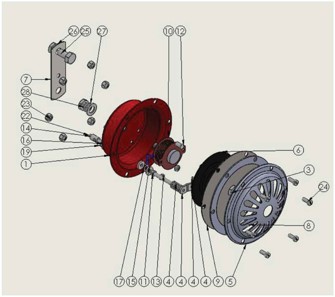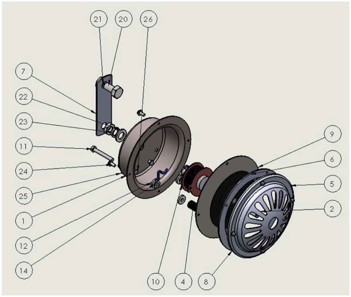Enabling Product Success with Design for X
- jackmillar7
- Aug 1, 2024
- 5 min read
Updated: Oct 11, 2024
Introduction
During the challenging process of product development, it is very common even the most skilled technology innovator to make early design-stage decisions that result in a product that is far too costly, heavy, difficult to transport and troublesome to manufacture. Unfortunately, this will reduce investor and customer confidence in both the product, and the innovator. Though worry not, by adopting a Design for X (DfX) philosophy with guidance from long-term DfX champions ,Blackfish Engineering, its possible to avoid these harmful domino-effects.
But what is DfX? DfX refers to a set of guidelines applied during the design process to optimize for a specific focus, denoted as "X." Understanding and implementing DfX can significantly impact the efficiency, cost, and success of engineering projects. In this blog post, we will explore what DfX is, who cares about it, when and how to implement it, and illustrate its practical applications. Finally, we will discuss how Blackfish Engineering can assist clients in leveraging DfX principles to enhance their projects.
What is Design for X (DfX)?
Design for X (DfX) is an engineering approach that integrates specific considerations into the design process to achieve particular objectives. The "X" in DfX can represent various factors such as manufacturability, sustainability, reliability, safety, cost, and more. The primary goal of DfX is to incorporate these considerations early in the design phase to avoid costly and time-consuming changes later on.

For an example of how Design for X principles has been applied to large-scale marine energy projects, check out our article on our managing directors' time at Tidal Generation Limited to learn how designing specifically for transportation was so key in the development of a tidal turbine. Click here to learn more.
Who Cares About DfX?
Various stakeholders benefit from the implementation of DfX:
Design Engineers: They can foresee and mitigate potential issues early, leading to more robust designs.
Manufacturers: By incorporating manufacturability considerations into the design process, production becomes more efficient and cost-effective.
Project Managers: Reduced iteration cycles and faster time to market result in better project management.
Environmental and Safety Officers: Ensuring sustainability and safety standards are met helps in regulatory compliance and environmental stewardship.
End Users: Products designed for reliability and ease of use lead to higher customer satisfaction while those developed with ease of manufacturing in mind can result in cheaper products.
When and How to Implement DfX
DfX principles are best employed in the early stages of design, much before the end of the detailed design phase, as this is the time in which there is the least associated cost for any design changes. Similarly, early changes have a greater influence on the overall final design than if changes were made later on.

Implementing DfX is a phased approach that involves:
Concept Design: Decide on what specific design focuses are to be targeted, and then implement best practices related to these in initial designs.
Detailed Design: Engage in specific DfX workshops focusing on the aspects important to stakeholders, such as manufacturing, assembly, and sustainability. This ensures that your detailed design is optimised for your specific focus before physical prototypes are made, reducing iteration count and cost of the design process.
Prototyping and Testing: Iterate on the design based on feedback from manufacturers, logistics experts and end users, or anyone else related to the specific focuses chosen. Note it is cheaper and potentially more worthwhile to take feedback on CAD designs, rather than producing a vast number of physical iterations and seeking feedback on each of these; remember, reduced iterations means reduced cost and time burden.
Production: Ensure key metrics related to the focuses chosen are measured, allowing the designer to assess processes / guidelines used when designing for that specific aspect. This will allow continuous feedback and improvement loops on the methodologies used.
Illustrating DfX
Let's illustrate DfX with by focusing on two specific cases: Design for Sustainability (DfS) and Design for Assembly (DfA).
Design for Sustainability (DfS)
DfS aims to minimize the environmental impact of a product throughout its lifecycle. Key principles include:
Modular Design: Allows for easy upgrades and repairs, reducing waste.
Longevity: Design products to last longer, countering planned obsolescence.
Local Sourcing: Reduces the carbon footprint by minimising transportation.
Material Choice: Using fewer environmentally harmful materials without compromising functionality.
Example: The EU's reintroduction of removable batteries in phones is a DfS initiative, promoting easier recycling and longer device lifespan.
Design for Assembly (DfA)
DfA focuses on simplifying the assembly process, making it more efficient and less error-prone. Key principles include:
Minimize Part Count: Fewer parts mean fewer assembly steps and lower error rates.
Ease of Handling: Design parts that are easy to manipulate and fit together.
Standardisation: Use standard parts and interfaces to simplify assembly.
Ease of access: Ensure that vital components are easy to access, ensuring maintenance is possible.
Example: A flowchart-based approach to determine the necessity of parts in assembly helps in reducing complexity and improving efficiency:

Case Study: Redesigning a Bike Horn
Though there's a million examples of Design for X principles being utilised, we thought it would be best to choose a case study that related to our company culture. With 75% of our staff cycling to the office, and numerous charity bike rides under our belts, it felt right to choose a case study that reflected our strong cycling culture. Therefore, here is a case study on the employment of DfX principles on the redesign of a bike horn.
In their paper 'Integration of DFMA and Sustainability - a case study' , Subbiah and Antony analysed an off-the-shelf bike horn with the goal of simplifying the manufacture and assembly process, as well as to make its production more sustainable. By applying design for manufacture and assembly principles, the redesign achieved:
23% Reduction in Parts: Simplified assembly and reduced material costs.
7.5% Reduction in Material Costs: Achieved through dematerialization.
34% Reduction in Manufacturing Costs: Optimized for manufacturability and assembly.
Bike horn before (left) and after (right) it was redesigned with design for manufacture and assembly and sustainability principles in mind. Source: Subbaiah & Antony, Integration of DFMA and Sustainability - a case study ,2021
Similarly, the resulting design saw a 13% reduction in carbon footprint, 8.7% reduction in energy required to manufacture and a 6.3% reduction in air acidification associated with manufacture. Therefore, by taking a DfX approach with sustainability, assembly and manufacture in mind, the authors managed to produce a similarly high quality design that was substantially simpler, cheaper and less environmentally damaging than the initial design!
How Blackfish Engineering Can Help
At Blackfish Engineering, we specialize in guiding our clients through the DfX process. Our services include:
DfX Workshops: We conduct collaborative workshops with all stakeholders, ensuring comprehensive consideration of manufacturability, assembly, and sustainability.
Detailed Analysis and Recommendations: Our experts analyze designs and provide actionable recommendations to optimize for various DfX factors.
Implementation Support: We assist in implementing the recommended design changes, ensuring smooth transition and integration into production.
Continuous Improvement: Post-implementation, we provide ongoing support to refine and enhance designs based on real-world feedback.
Want to learn more about how Blackfish Engineering can help you through the DfX process? Click below to learn more!
Conclusion
Design for X (DfX) is a powerful methodology that can transform the engineering design process, leading to more efficient, cost-effective, and in some cases, sustainable products. By considering specific factors early in the design process, DfX helps avoid costly revisions and ensures better overall project outcomes. At Blackfish Engineering, we are committed to helping our clients leverage DfX principles to achieve their project goals and drive innovation in their respective industries. Whether you are looking to optimize for manufacturability, sustainability, or any other factor, we have the expertise and experience to guide you through the process and deliver tangible results.








Comments